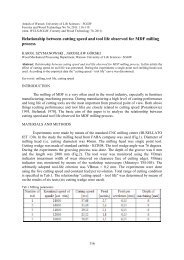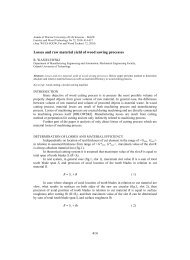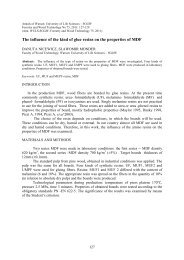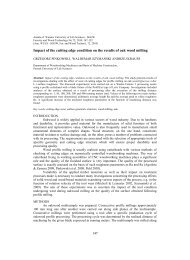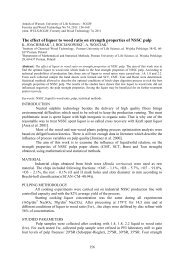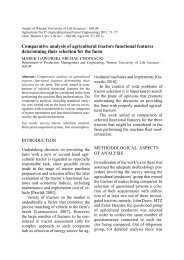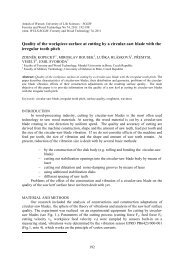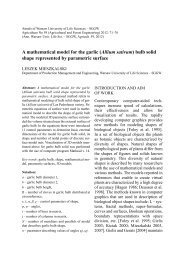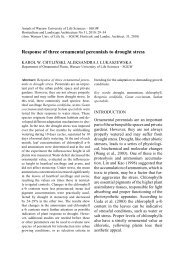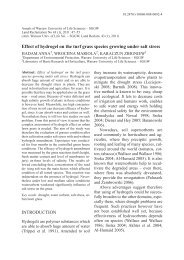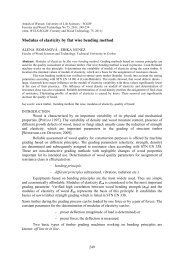Annals of Warsaw University of Life Sciences – SGGW. Animal ...
Annals of Warsaw University of Life Sciences – SGGW. Animal ...
Annals of Warsaw University of Life Sciences – SGGW. Animal ...
You also want an ePaper? Increase the reach of your titles
YUMPU automatically turns print PDFs into web optimized ePapers that Google loves.
16 K. Fiszdon, K. Góral, J. Narojek<br />
increases. According to Horwitz (1997),<br />
among 100 cats that presented this kind<br />
<strong>of</strong> problems, 65% were kept in multianimal<br />
household, 50 <strong>of</strong> them (77%)<br />
lived with another cat, and 23% with<br />
more animals. Also Seksel (2000) claims<br />
that marking increases proportionally to<br />
number <strong>of</strong> cats that live in one place.<br />
As far as sex is concerned, it is worthy<br />
to note that frequency <strong>of</strong> marking increases<br />
twice in neutered animals, both males<br />
and females (Tab. 2). The difference<br />
between neutered and intact animals was<br />
statistically significant. Nevertheless,<br />
Marder (1991) and Patronek et al. (1996)<br />
concluded opposite <strong>–</strong> marking was more<br />
frequent in intact animals. Seksel (2000)<br />
claims that this behaviour appear mainly<br />
in males, and castration does not have<br />
any influence on it. In our survey marking<br />
was not separated as such from urination/defecation.<br />
These behaviours were the least frequent<br />
in purebred cats and the most frequent<br />
in mix bred ones, i.e. those having<br />
one purebred parent, yet differences were<br />
not statistically significant. They were<br />
also relatively rare in cats that were born<br />
and reared in their permanent homes,<br />
whereas they were <strong>of</strong>ten reported with<br />
adopted cats (Tab. 2). Again, these differences<br />
were not statistically significant,<br />
most probably due to obviously different<br />
numbers <strong>of</strong> animals in each group.<br />
Additionally, age <strong>of</strong> children seems to<br />
influence the behaviour <strong>–</strong> it occurs with<br />
higher frequency in homes with children<br />
<strong>of</strong> 0<strong>–</strong>4 and 14<strong>–</strong>18 years <strong>of</strong> age. Even though<br />
differences were seemingly obvious, they<br />
could not be statistically confirmed.<br />
Aggression towards other cats<br />
Among all abnormal or unacceptable behaviours<br />
the next common one is aggression<br />
towards other cats. It was reported in<br />
53 specimens, i.e. almost 20% <strong>of</strong> all cats<br />
included in the survey. Studies in <strong>Animal</strong><br />
Behaviour Clinic, Cornell <strong>University</strong>,<br />
show that in 13.5% <strong>of</strong> homes with more<br />
than one cat cases <strong>of</strong> aggression were<br />
observed. Studies on aggression caused<br />
by introduction <strong>of</strong> another cat into household<br />
(Levine et al., 2005) showed that its<br />
cases appeared in almost 50% <strong>of</strong> such<br />
households. Borchelt and Voith (1996)<br />
report cat fights with frequency at least<br />
once a month in 44% <strong>of</strong> homes.<br />
In the study was found that age <strong>of</strong><br />
cats and level <strong>of</strong> aggression were correlated<br />
(V = 0.242). Aggression was most<br />
common among old cats (over 8 years)<br />
and more than twice less common in<br />
younger ones (Tab. 3). Beaver (2003)<br />
claims that elderly cats are more likely to<br />
show aggressions towards kitten, while<br />
Levine et al. (2005) did not find any relation<br />
between age <strong>of</strong> cats and aggression.<br />
Another important factor were living<br />
conditions (V = 0.153) (Tab. 3). Aggression<br />
was most frequent among cats that<br />
were allowed out, whereas it was least<br />
frequent among those kept permanently<br />
inside. Similar result was reported by<br />
Levine et al. (2005) <strong>–</strong> in his study aggression<br />
cases were 3<strong>–</strong>4 times more common<br />
in the first group.<br />
Aggression towards other cats was<br />
also most common in spayed females<br />
(30%) and lest common in intact males<br />
(only 11.4%) (Tab. 3). This difference<br />
was, however, statistically insignificant.<br />
Other studies report different results.<br />
Landsberg et al. (2003) claims that highest<br />
level <strong>of</strong> aggression can be observed<br />
among males. Lindell et al. (1997) report<br />
that males tend to be most aggressive, and<br />
their aggression is directed both to other<br />
males as well as to females. According to



